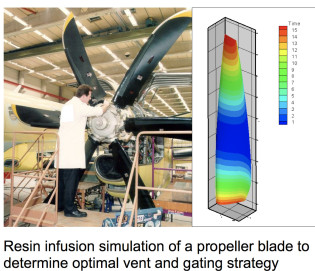Composite Manufacture and Repair
Manufacture has been a critical bottleneck in the uptake of composites by industry, and the rapidly expanding and changing portfolio of composite constituents and architectures means a diverse range of processing routes need to be developed and understood. The Composite Centre has an knowledgeable and experienced team of staff to support this area as well as diverse range of facilities for research and development of composite manufacture. In parallel, we have expertise in predictive modelling processes associated with composite manufacture and repair.
Additive manufacturing of ceramic-based composites
We have been working on the development of additive manufacturing technologies to fabricate ceramic-based composites. In particular, we are concentrating on the use of robotic assisted deposition (robocasting) to fabricate fibre and platelet-reinforced composites. The goal is to build composite parts with a range of geometries that will exhibit complex hierarchical microstructures. To achieve this goal we are developing ceramic inks with controlled rheology for 3D printing and using external fields to manipulate particle alignment. The microstructures can be designed to direct crack propagation at the microscopic level in three dimensions and develop tough materials with high specific strengths. We have developed a series on in situ mechanical tests in the scanning electron microscope that enables us to identify the salient toughening mechanisms. This work is supported by the CASC Industrial consortium formed by Morgan Advanced Materials, Safran, Asahi Glass, John Crane and Reaction Engines. Extension of the research to new materials combining mechanical and functional properties is being investigated with EPSRC funding (MAPP, Future Manufacturing Hub in Manufacture using Advanced Powder Processes).
Interleaved composites for easy repair of impact damage
Prof P. Robinson, Prof A. Bismarck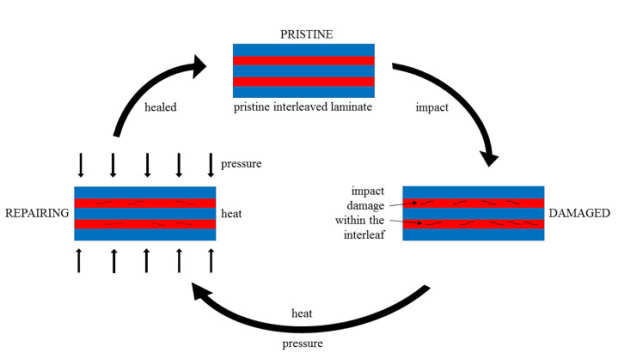
An 'easy-repair' laminate concept is proposed to address the repair problem posed by interlaminar damage due to impact. In this concept a conventional carbon epoxy laminate is interleaved with a material which can is thermally bondable to itself. The interleaf material must be chosen so that the impact damage occurs predominantly within the interleaf and not at its interface with the composite or within the epoxy matrix. The idealised damage-repair cycle of the proposed interleaved composite is shown in figure. On impact the interleaved composite would fail within the interleaf layer due to impact. The laminate could then be heated to initiate bonding, perhaps accompanied by external pressure, and so restore the initial pristine state.
A carbon epoxy laminate interleaved with PLA has been shown to preferentially fail in shear within the interleaf. Good strength recovery is achieved when the laminate is heated and subjected to external pressure. However, PLA has a relatively low shear strength. Further work is being conducted to identify alternative interleaf materials.
Aerial Additive Building Manufacturing
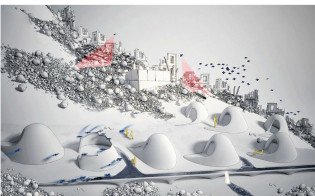
Aerial robots with the capability to autonomously construct structures would be invaluable in many applications: building temporary shelters following natural disasters such as earthquakes and floods, deploying scaffolding and support structures on conventional construction sites, or assembling ramps across gaps and difficult terrain to enable access to terrestrial vehicles. However, construction in unstructured environments would require aerial robots that adapt to terrains and layouts unique to individual physical sites. Our goal is to develop novel autonomous manufacturing methods by investigating techniques for building physical structures with aerial robots. The work is largely inspired by the way how animals, such as birds and bees, build structures using environmental material in combination with adhesives and intricate architectural designs.
Manufacture of multifunctional materials
Prof E. S. Greenhalgh, Prof M. Shaffer, Prof A. Kucernak, Dr K-Y Lee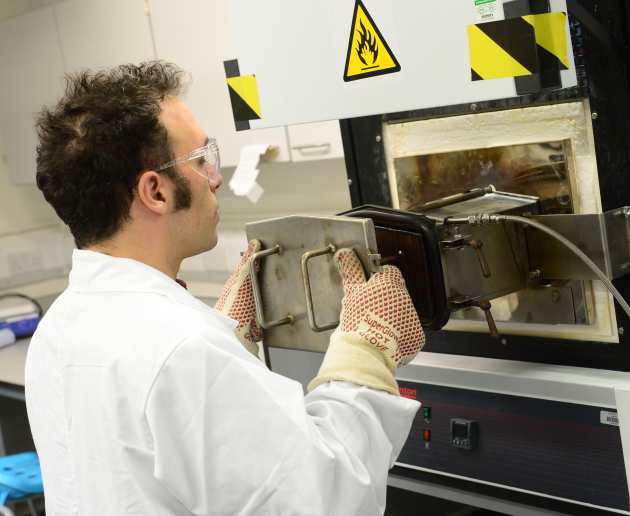
Having demonstrated multifunctional composites, one of the critical challenges is now to scale-up the manufacture of these materials. This includes dealing with fabrication and assembly of multiple devices, encapsulation and hybridisation with conventional materials, making curved components and electrical integration with the surrounding structures. Through EPSRC funding under the Composite Manufacturing Hub we are investigating how to make composite components using these materials, and addressing the critical research challenges which hinder the uptake of this emerging class of materials by industry.
CFD simulation of moulding processes
The research is aimed at developing fast and accurate CFD methods for modelling and simulation of processes for manufacturing textile composite components with bi-directional and woven fabric geometries via resin infusion methods. The overarching aim is to encourage and facilitate their industrial use in the early-design stages of composite structures. Current interest is to extend these techniques to the modelling of manufacturing using thermoplastics.
Multifunctional Composites via Additive Manufacturing
Dr Ajit Panesar, Dr Koon-Yang Lee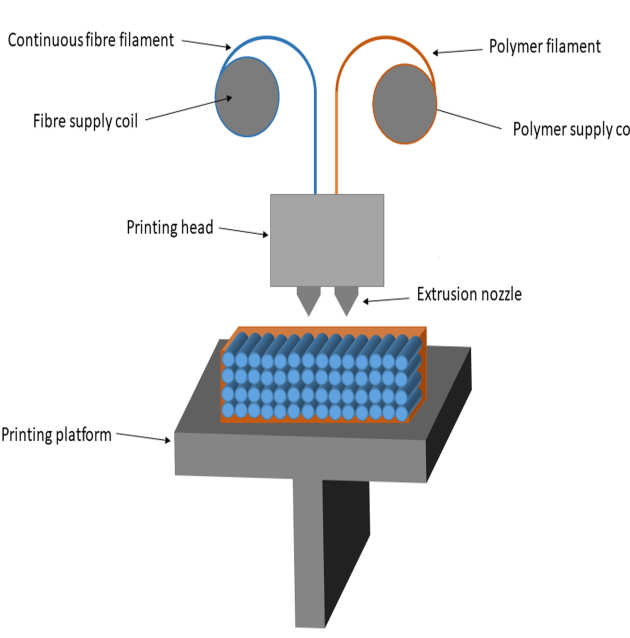
The recent developments in the field of Additive Manufacturing (AM) have enabled the manufacture of composite structures with tailored geometries which through traditional processes would have been either very challenging or impossible. Though in its infancy, these nascent processes are littered with challenges. In particular, the poor performance of manufactured parts. This project embarks on the quest to understand the process- and material- related aspects to realise composites not only with high fibre content and superior mechanical properties but also with embedded functionalities such as electric, magnetic and thermal etc.
Additive manufacturing (AM) of metal composites
Dr. Qianqian Li, Prof. Carolin Karner
In this project, metal composites produced by additive manufacturing are to be investigated, both on their production process and the sample analysis. The dispersion of nanoparticles in the metal matrix powder bed will be studied and the manufacturing parameters are optimised. The mechanical properties of the samples will be measured and the microstructure will be explored.
Repair of composite components
Dr Sharif Khodaei, Prof F Aliabadi 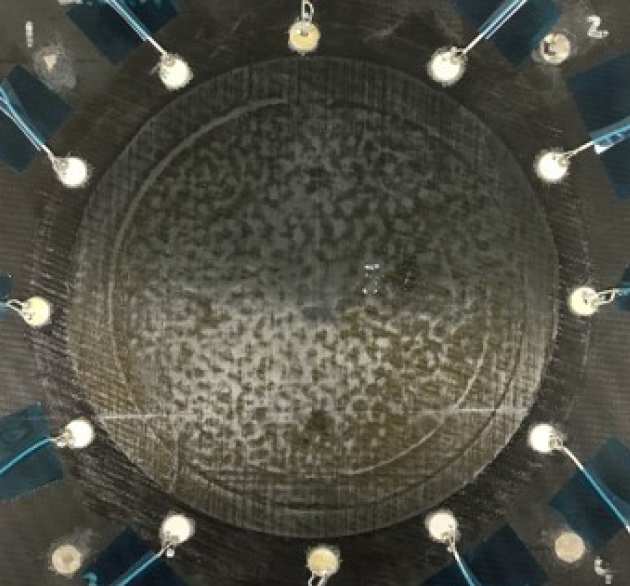
With new aircraft featuring composites in their primary structures, their service repair needs to be addressed by the maintenance and repair organizations (MROs). The structural integrity group at the Aeronautics department have been involved in developing smart bonded repair concept to be able to monitor the bonding quality of the composite patch repair as well as its integrity in operation. Various sensor technologies such as PZTs, FOs and conductivity sensors (by 3D printing) have been developed and tested to monitor the integrity of the bondline.




